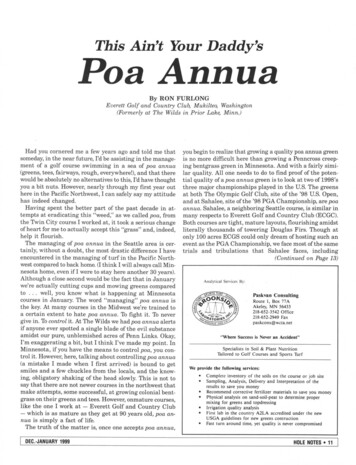
Transcription
This Ain't Your Daddy'sPoa AnnuaBy RON FURLONGEverett Golf and Country Club, Mukilteo, Washington(Formerly at The Wilds in Prior Lake, Minn.)Had you cornered me a few years ago and told me thatsomeday, in the near future, I'd be assisting in the management of a golf course swimming in a sea of poa annua(greens, tees, fairways, rough, everywhere!), and that therewould be absolutely no alternatives to this, I'd have thoughtyou a bit nuts. However, nearly through my first year outhere in the Pacific Northwest, I can safely say my attitudehas indeed changed.Having spent the better part of the past decade in attempts at eradicating this "weed," as we called poa, fromthe Twin City courss I worked at, it took a serious changeof heart for me to actually accept this "grass" and, indeed,help it flourish.The managing of poa annua in the Seattle area is certainly, without a doubt, the most drastic difference I haveencountered in the managing of turf in the Pacific Northwest compared to back home. (I think I will always call Minnesota home, even if I were to stay here another 30 years).Although a close second would be the fact that in Januarywe're actually cutting cups and mowing greens comparedto . . . well, you know what is happening at Minnesotacourses in January. The word "managing" poa annua isthe key. At many courses in the Midwest we're trained toa certain extent to hate poa annua. To fight it. To nevergive in. To control it. At The Wilds we had poa annua alertsif anyone ever spotted a single blade of the evil substanceamidst our pure, unblemished acres of Penn Links. Okay,I'm exaggerating a bit, but I think I've made my point. InMinnesota, if you have the means to control poa, you control it. However, here, talking about controlling poa annua(a mistake I made when I first arrived) is bound to getsmiles and a few chuckles from the locals, and the knowing, obligatory shaking of the head slowly. This is not tosay that there are not newer courses in the northwest thatmake attempts, some successful, at growing colonial bentgrass on their greens and tees. However, onmature courses,like the one I work at — Everett Golf and Country Club— which is as mature as they get at 90 years old, poa annua is simply a fact of life.The truth of the matter is, once one accepts poa annua,you begin to realize that growing a quality poa annua greenis no more difficult here than growing a Penncross creeping bentgrass green in Minnesota. And with a fairly similar quality. All one needs to do to find proof of the potential quality of a poa annua green is to look at two of 1998'sthree major championships played in the U.S. The greensat both The Olympic Golf Club, site of the '98 U.S. Open,and at Sahalee, site of the '98 PGA Championship, are poaannua. Sahalee, a neighboring Seattle course, is similar inmany respects to Everett Golf and Country Club (ECGC).Both courses are tight, mature layouts, flourishing amidstliterally thousands of towering Douglas Firs. Though atonly 100 acres ECGS could only dream of hosting such anevent as the PGA Championship, we face most of the sametrials and tribulations that Sahalee faces, including(Continued on Page 13)A n a l y t i c a l Services By:Paskvan ConsultingRoute 1, Box 77AAkeley, M N 56433218-652-3542 O f f i c e218-652-2949 Faxpaskcons@wcta.net"Where Success is Never an Accident"Specialists in Soil & Plant NutritionTailored to Golf Courses and Sports TurfWe provide the following services: Complete inventory of the soils o n the course or job siteSampling, Analysis, Delivery and Interpretation of theresults to save you moneyRecommend corrective fertilizer materials to save you moneyPhysical analysis on sand-soil-peat to determine propermixing for greens and topdressingIrrigation quality analysisFirst lab in the country A 2 L A accredited under the newUSGA guidelines for new greens contructionFast turn a r o u n d time, yet quality is never compromised
Be Than fuCSpend Time with TamiCyCeCe6rate the SeasonMay the happiness and good cheer of theJfodday Season 6e yours throughout theNew Year.
Poa Annua—(Continued from Page 11)the managing of our poa greens.In the Pacific Northwest, poa is seen commonly as awinter annual. After flowering and seeding, the annualsdie, leaving dormant seed behind to germinate whenmoisture returns (moisture is definitely not a problem herefrom October through April). Mature courses tend to havemore favorable, higher quality types of poa than the newer courses in this region. Studies have shown as many as20 different biotypes of annual bluegrass may exist on asingle putting green. Another fact that makes poa annuaa good grass for a putting green is the high shoot densities. As Dr. David R. Huff pointed out in a recent USGAarticle, a quality Penncross creeping bentgrass green willhave about 200 to 250 tillers within a square inch, compared to a similar healthy poa annua reptans green whichmay have as many as 1300 shoots in the same area.Our greens management program here at ECGC, instituted by CGCS Randy White, is similar in many respectsto that of a Midwest program. A spring and fall aerification and topdressing; light topdressing throughout the year,about every third or fourth week; a verticutting and spiking program in the summer; occasional hydroject aerification throughout the year, as well as occasional solid coretining; a sound fertility program, and the mad scrambleduring the hot months of July and August to keep the deli-cate grass alive with proper irrigation. There are, of course,many differences as well. We are not hit with pythium ordollar spot here, but instead anthracnose and fusariumreign terror. No cutworms, but the European Crane Fly isa nasty little replacement (crows love to peck at the greenslooking for the larvae). But here, like anywhere, golferswant speed (we roll twice a week in the summer months)and conditions just like those they saw on television on Sunday. The Augusta syndrome. Some problems are, alas,universal.Most are aware, of course, of the testing done over the pastfew years at the University of Minnesota by Donald White,Ph.D., which has actually produced a poa annua reptans(creeping bluegrass) seed for sale on the market. DW 184.According to White, once established, DW 184 producesvery few flowers, is dense, upright, dark green and has displayed good resistance to a variety of diseases. Still, convincing someone in Minnesota that poa annua is theanswer for them may as yet be a hard sale. Some ways arehard to change, and certainly being forced into the change,as I was when I made my move to the Seattle area, wasan easier way of facing up to this conversion. I simply hadno choice. Yet, even in Minnesota, I think one has to lookat the situation with an open mind and say to oneself, isthis the way to go? Should I suddenly embrace somethingI have spent so long trying to eliminate? Time will tell.QUALITY CONSTRUCTION &RECONSTRUCTIONQUALITY SUPPLIER OF TURF W a s h e d and Regular Turf (Sod) in l1'2 yd. orup to 55 yd. Big Roll Size (42" Wide) Golf Courses Sports FieldsTURF TYPES:ELITE KENTUCKY BLUEGRASS BLENDGLENN,SPORTS TURFBLUEGRASS/R RYEGRASS BLENDBENTGRASSFor Quality Turf Contact:(612) 674-7937 FAX: (612) 674-7044DEC- JANUARY 1999NETLON ADVANCED TURF SYSTEMSSelf-Cultivating means healthier turfand better AISTMATP I St N Eg651Blaine, MN 55449 "NETLON* M E S H E L E M E N T S A N D M I X E SFor Compaction Resistance on cart paths,sports fields and other high use areas.F r Construction & Nelton Products Contact:(612) 784-0657 FAX: (612) 784-6001HOLE NOTES 13
GREENSMASTER 3100 Available in 2 or 3-wheel drive Quick response power steering Equipped with Toro'sTurf Guardian leak detector Sure-footed tractionEQUIPMENT FINANCEPROGRAMS AVAILABLEContact YourMTI Representative Today Troubleshooting Cutting Unit Rebuilding/Sharpening Electrical Diagnostics & Repair Hydraulic Diagnostics & Repair Engines - Motor Repair/Rebuilding troubleshooting Refurbishing/Updating Solid State Electro/MechanicalCall Randy Mackehen, Ext. 229WATCH FOR OUR FALLWINTER SERVICE SPECIALS
EMERGENCY AFTER HOURSIRRIGATION SERVICECall 612-475-2200, Ext. 302 or1-800-362-3665, Ext. 302(For service during regular business hours,8:00 am - 4:30 pm, Monday - Friday,call John Artus at the above numbers,but use ext. 205) Completely modular, expands fromeight to 48 stations Retrofits existing satellites withoutadding wires or altering hardware Operates from any location viaremote control Motorola quality and radio expertisePICTURE-PERFECT'IRRIGATION CONTROLSitePro is irrigation managementwïÊÊÊÊÊJ- Tor we tT /1* * GGfi lLifV*PREDICTABI Y TOkOCall for a product14900 21st Avenue North Plymouth, MN 55447612-475-2200 800-362-3665:' P i - 'ftftftft:. . ft &:: fti; :. ft: : .ft .,;. .,. ./. 5 ., .gdemo4310 Main Avenue Fargo, ND 58103; . s .; . ' / - V, 03, ft;.:. : . . . 1:ftl
Garske ScholarshipsNow in Third YearNamed after the founder of ParAide Products Co., the Joseph S.Garske Legacy Awards now are intheir third year of funding twoscholarship grants to children andgrandchildren of MGCSA members.The Par Aide firm, located in St.Paul, contributes 2,500 annually,divided into two grants. This year Lucas A. Mahal, son of Doug Mahal, su-Not every hole has to have aWATER HAZARD!Prinsco PE pipe will keep yourgreens and fairways dry.and always ready to play.PRINSCOManufacturers of GOLDFLO Dual-Wall andGOLDLINE Corrugated Polyethylene Pipe800-992-1725IIperintendent at The Minikahda Club,received his second grant of 1,250.He is a natural resources student atVermilion Community College in Ely.Awarded her first 1,250 grant forthe 1998-99 school year was AmyMounts, Evansville, daughter of PeterMounts, superintendent at TipsinahMounds Golf Club, Elbow Lake. Amyis a computer science student at theUniversity of Minnesota in Morris.The late Mr. Garske, who died at theage of 76 in 1982, started Par Aide in1954 with plans to make a "good" ballwasher. A foundryman and avid golfer, he knew little about the golf business, tried to sell his ideas for designand tooling to two accessory companies, was turned down by both and sobegan Par Aide Products Company.The Garske scholarships were started two years ago by Joseph Garske'sson, Steve, who noted that his father"was an orphan with only a sixthgrade education and was selfconscious about his lack of formalschooling, but he always wanted tohelp young people with their education.""I am pleased to have our companyprovide these scholarships since thesuperintendent's job has become evermore demanding and, for many superintendents, providing a collegeeducation for their children requirestrue sacrifice," Garske said. "I am fortunate to have the opportunity andability to help."For more information about applying for these and other MGCSAscholarships, call the MGCSA officeat (612) 473-0557 or toll free at1-800-642-7227 or fax (612) 473-0576.
How Does He Stay So Long?By JACK KOLBMGCSA Life MemberI have often said that it is easy to write about someonewho has a lot of interests and I am sure that individualhas been found in the person of Ronald C. Fabian. Generally we write about former Superintendents. This gentleman has been around so long that I was sure retirementhad taken place. Not so! The name Fabian has been associated with Winona Country Club since 1939. It wasRon's father who started work as Golf Course Superintendent at that time.I had met Ron in March of 1953 at the 25th Annual TurfConference held at the Curtis Hotel in downtown Minneapolis. He was there to pick up as much information aspossible so he could replace his dad as Golf Course Superintendent that Spring. Thus as I began looking for retired"Soups," you would think that 45 years later Ron wouldqualify.To digress for a moment — it might behoove us to knowthat Winona Country Club was opened in 1920 as a ninehole course. The course was deisgned by Ben Knight, aScotsman from Aberdeen, Scotland. He seemed to havebeen a multi-talented individual. He was born in 1889 andRon Fabian working on his Worthington "Overgreentheforerunner of triplex green mowers. Son Dennis is interested in Mom the photographer. The "Overgreen" had onemower mounted between the large wheels and two following. The operator was accessible by the long handle-bars.Photo taken in 1955.emigrated to the USA in 1909 as a 20-year-old with a background in engineering. His talents led him into many endeavors in many parts of the country. Several of his jobswere in association with the construction of Golf Courses.After a short hitch in the U.S. Army during World War I,Great Grandfather Carl Fabian aboard his new Worthington tractor. This picture was taken in 1944.he wound up in Winona, Minnesota and was commissionedto design Winona Country Club in 1919. Upon the opening of the new club in 1920 Ben Knight stayed on as theGolf Pro for the next 31 years and retired in 1951. WinonaCountry Club is in a beautiful setting. It takes you out oftypical Minnesota landscape and puts you in a New England setting such as Vermont. It is located in a deep valley with high, cliff-like, heavily wooded hills surrounding.The geology is so different than the average MinnesotaPrairie Golf Course.Carl Fabian (Ron's father) became Superintendent in1939 and retired from the course in 1953 at which pointRon Fabian took over. Ron, of course, grew up on the courseand began working as a 12-year-old making 22.50 per60-80 hour week during the summer. As Ron explains hedid everything that had to be done in a crew of 3-4 men.In 1964 construction began on the second nine andopened in August of 1966, thus Winona Country Club became an 18-holer. Three tennis courts, automatic irrigationand, swimming pool completed in the mid 70's brought thecourse into "Country Club" status.In high school Ron became a musician specializing as anaccordionist. He often brought h
11.12.1998 · This Ain't Your Daddy's Poa Annua By RON FURLONG Everett Golf and Country Club, Mukilteo, Washington (Formerly at The Wilds in Prior Lake, Minn.) Had you cornered me a few years ago and told me that someday, in the near future, I'd be assisting in the manage-ment of a golf course swimming in a sea of poa annua (greens, tees, fairways, rough, everywhere!), and that there would be











